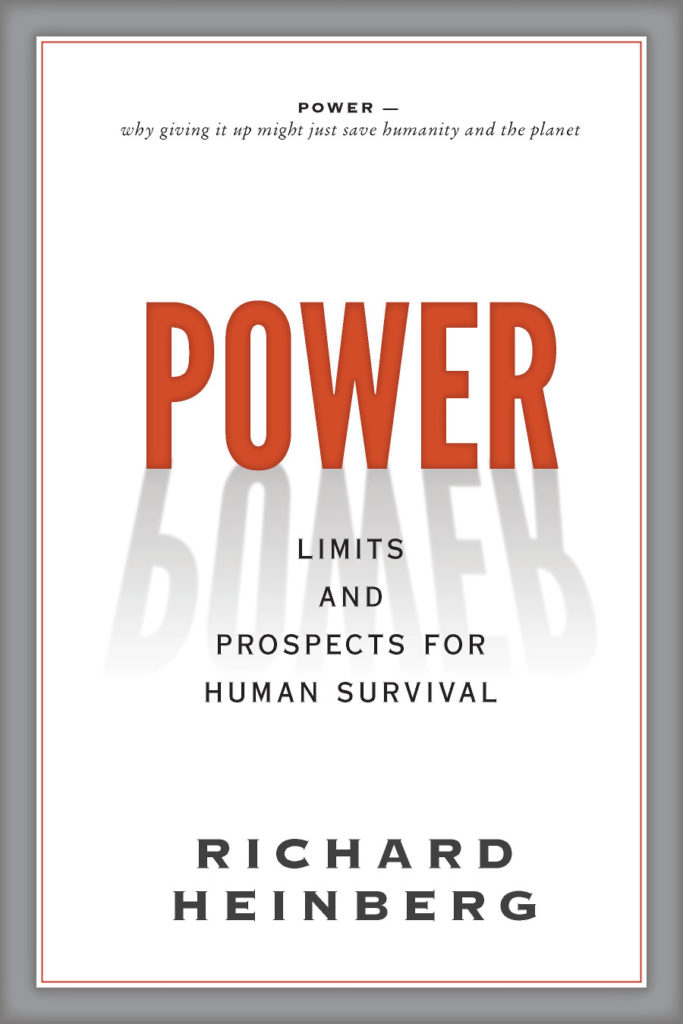Descrption & table of contents

Power: Limits and Prospects for Human Survival
By Richard Heinberg
New Society Publishers, September 2021
Paperback, 416 pages. ISBN 978-0865719675.
Also available as an eBook and audiobook.
This is the story of power ― humanity’s power over nature and the power of some people over others.
How has Homo sapiens become powerful enough to threaten a mass extinction and disrupt the Earth’s climate? Why have we developed so many ways of oppressing one another? Can we change our relationship with power to avert ecological catastrophe, reduce social inequality, and stave off collapse? These questions ― and their answers ― will determine our fate.
Power traces how four key elements developed to give humans extraordinary power: tool making ability, language, social complexity, and the ability to harness energy sources ― most significantly, fossil fuels. It asks whether we have, at this point, overpowered natural and social systems, and if we have, what we can do about it.
Most crucially, the book explores how self-limitation of power is rooted in evolution and human history and why, at this vital moment, we must rapidly relearn the lessons of power if humanity is to have a thriving future.
Chapters
Introduction
Chapter 1. Power in Nature: From Mitochondria to Emotion and Deception
- The Basis of Life’s Power
- Power and Bodies
- Power and Behaviors
- Proto-Human Powers
Chapter 2. Power in the Pleistocene: On Spears, Fires, Furs, Words, and Flutes—And Why Men Are Such Power-Hogs
- Hands and Stone
- The Fire Ape
- Skins
- From Grunts to Sentences
- Gender Power
- The Power of Art
Chapter 3. Power in the Holocene: The Rise of Social Inequality
- Gardening, Big Men, and Chiefs: Power from Food Production
- Plow and Plunder: Kings and the First States
- Herding Cattle, Flogging Slaves: Power from Domestication
- Stories of Our Ancestors: Religion and Power
- Tools for Wording: Communication Technologies
- Numbers on Money
- Pathologies of Power
Chapter 4. Power in the Anthropocene: The Wonderful World of Fossil Fuels
- It’s All Energy
- The Coal Train
- Oil, Cars, Airplanes, and the New Middle Class
- Oil-Age Wars and Weapons
- Electrifying!
- The Human Superorganism
Chapter 5. Overpowered: The Fine Mess We’ve Gotten Ourselves Into
- Climate Chaos and Its Remedies
- Disappearance of Wild Nature
- Resource Depletion
- Soaring Economic Inequality
- Pollution
- Overpopulation and Overconsumption
- Global Debt Bubble
- Weapons of Mass Destruction
Chapter 6. Optimum Power: Sustaining Our Power Over Time
- Involuntary Power Limits: Death, Extinction, Collapse
- Self-Limitation in Natural and Human-Engineered Systems
- Taboos, Souls, and Enlightenment
- Taxes, Regulations, Activism, and Rationing: Power Restraint in the Modern World Games, Disarmament, and Degrowth
- Denial, Optimism Bias, and Irrational Exuberance
Chapter 7. The Future of Power: Learning to Live Happily Within Limits
- All Against All
- Trade-Offs Along the Path of Self-Restraint
- The Fate of the Superorganism
- Questioning Technology
- Learning to Live with Less Energy and Stuff
- Lessening Inequality
- Population: Lowering it and Keeping It Steady
- Fighting Power with Power
- Long-Term Power through Beauty, Spirituality, and Happiness
Sidebars
Introduction
1. Defining Power
Chapter 1
2. Powers in Math
3. Measures of Physical Power
4. How Much Power?
Chapter 2
5. Ominous Power from Space: Asteroids, Comets, and Climate Change
6. A Watery Theory of Human Origins
7. Male Violence
8. Human Aesthetic Decadence
Chapter 3
9. Measures of Social Power
10. Pandemics and the Evolution of States and Empires
11. Slavery and Power
12. DNA Evidence for Steppe Invasions
13. Justifying Colonialism
14. The Original Sins of Mainstream Economists
15. Institutional Power
16. Genocide as Ultimate Exclusionary Social Power
17. Key Writers on Power
Chapter 4
18. An Arrested Industrial Revolution in China
19. Geopolitics: Global Power
Chapter 5
20. Personal Carbon Output
21. Rising Risk of Disease and Pandemic
22. Inequality in Economic and Political Power in the US, and Its Consequences
23. Guns: The Power to Kill Cheaply and Easily at a Distance
Chapter 6
24. The 2,000-Watt Society
Chapter 7
25. Viktor Frankl and the Will to Meaning
26. Dethroning GDP: Key to Limiting the Power of the Superorganism
27. Energy and Human Values
28. Advice to Young People in the 21st Century
29. Power Analysis and Organizing for Activists
Figures
1.1 Proton pumping in a bacterium
1.2 Exponential growth
1.3 The energy pyramid in nature
1.4 Visualization of Kleiber’s law
2.1 Global temperatures during the Pleistocene and Holocene
2.2 Key language, motor, and auditory areas of the brain
3.1 Placement of people on a slave ship
5.1 Global wildlife decline
5.2 Global extraction/production of resources in 1875, 1945, and 2015 (metric tons)
5.3 Power Center import vulnerability ratings of nonrenewable resources
5.4 United States top one percent income share (pre-tax)
5.5 Growth in total global debt by sector, 1999-2019
5.6 Gun ownership and violent deaths
6.1 Predator/prey dynamics
6.2 The adaptive cycle